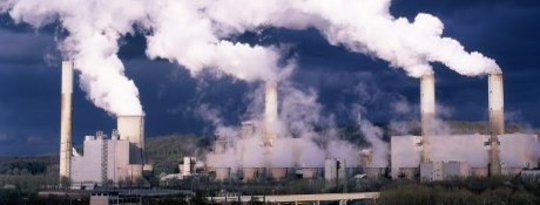
By Bobby Magill
U.S. carbon dioxide emissions related to energy increased in 2013 for the first time in three years, possibly the first sign that a trend in declining emissions from energy consumption has ended for now.
The U.S. Energy Information Administration released a report on Monday showing that 2013 energy-related CO2 emissions in the U.S. are expected to have increased 2 percent over 2012 emissions once all the data for the year are tallied. Total CO2 emissions from fossil fuels totaled 5.26 billion metric tons in 2012, increasing to 5.37 billion in 2013, EIA data show.
The report also projects that emissions will increase slightly — 0.7 percent — in 2014, followed by no change in emissions in 2015.
A graph showing U.S energy-related CO2 emissions since 2005 Credit: U.S. Energy Information Administration
The majority of CO2 emissions in the U.S. come from the energy sector and include emissions from electrical power generation, transportation, manufacturing, home heating, commercial buildings, and other industrial sources.
Energy-related CO2 emissions hit their lowest point since 1994 in 2012 because of the decline of coal as a power source in favor of natural gas, the EIA reported in October last year. That trend may have leveled off in 2013 as higher natural gas prices led to an increase in coal burning at U.S. power plants. EIA statistician Tyson Brown said that switch is responsible for the rise in emissions.
The rise in coal use might be short-lived, though. The EIA projects that CO2 emissions from coal will decline 2.5 percent in 2015 as utilities close some coal-fired power plants to meet new federal mercury and air pollution regulations.
“Natural gas prices have come back a good bit since the April of 2012 low,” he said. “The electric power sector is very price-responsive.”
Prices for natural gas are expected to remain stable through 2015, keeping coal and natural gas consumption for power generation roughly the same during that time, he said.
Natural gas prices dipped in recent years because the nationwide fracking boom has made natural gas abundant in the U.S. That boom, which has climate implications of its own because of unquantified methane emissions, has allowed energy companies to produce natural gas from previously untapped sources, including the Marcellus shale region of Pennsylvania, the Niobrara shale in Colorado and elsewhere.
A natural gas drilling rig Credit: U.S. Department of Energy
As the fracking boom exploded and utilities began to switch from coal to natural gas power plants, power generation from natural gas increased by 211.8 billion kilowatt hours in 2012 over 2011. Coal declined in 2012 by 215 billion kilowatt hours over the same period, EIA data released in October show.
Coal accounted for about 37 percent of total U.S. electricity generation in 2012. Natural gas was responsible for 30 percent of power generation that year, followed by nuclear at 19 percent and renewables at 12 percent, EIA data show.
The slight increase in energy-related CO2 emissions in 2013 had little impact on the country’s overall CO2 emissions for the year, which were just under 10 percent below 2005 levels, according to EIA data. The Obama administration’s goal is for overall CO2 emissions, among the primary drivers of climate change, to be 17 percent lower than 2005 levels by 2020.
Related Content
Natural Gas, Efficiency Fuel U.S. Carbon Emissions Decline
Can U.S. Carbon Emissions Keep Falling?
Fracking Boom Leading to Fracking Bust: Scientists
Scientists: Lack of Data Means Fracking Impacts Unknown
Follow the author on Twitter @bobbymagill or @ClimateCentral. We're also on Facebook & other social networks.
This article, U.S. Energy-Related CO2 Emissions Increased in 2013, is syndicated from Climate Central and is posted here with permission. An article from NJ News Commons. This article was originally shared via the Repost Service. .

























